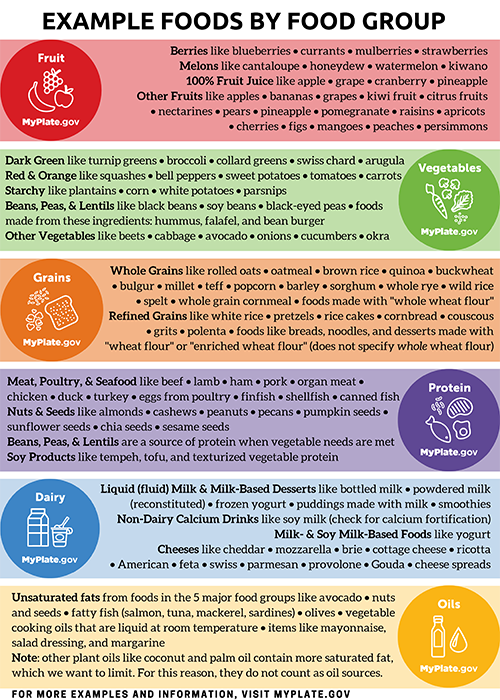This year, UGA SNAP-Ed is excited to start a new series of blogs! We are calling it “Food Talk Features…” and will be sharing information about our favorite topic: Food!
We’ll be featuring a food group or sub-group each month to share the benefits of that food group and our favorite recipes with those foods.
To kick off the series, let’s get familiar with the food groups. There are five major food groups:
- Fruits
- Vegetables
- Grains
- Protein Foods
- Dairy
… And a bonus “group” for important nutrients:
- Oils (not shown in graphic below)
![]()
Foods from each group should be included in most meals you eat. The balance of nutrients from each food group will help you meet your nutrition needs. MyPlate is the United States Department of Agriculture’s approach to building a balanced plate. MyPlate focuses on these main messages:
- Make half your plate fruits and vegetables: Focus on whole fruits
- Make half your plate fruits and vegetables: Vary your veggies
- Make half your grains whole grains
- Vary your protein routine
- Move to low-fat or fat-free dairy milk or yogurt (or lactose-free dairy or fortified soy versions) [1]
After reading about the food groups, you might be saying, “That sounds familiar!” That is great! If you aren’t sure what foods count as fruits, vegetables, grains, proteins, dairy, or oils [2], here are some examples of foods in each food group:

- Fruits
- Berries like blueberries, currants, mulberries, and strawberries
- Melons like cantaloupe, honeydew, watermelon, and horned melon (kiwano)
- 100% fruit juice like apple juice, grape juice, cranberry juice, and pineapple juice
- Other fruits like apples, bananas, grapes, kiwi fruit, citrus fruits, nectarines, pears, pineapple, pomegranate, raisins, apricots, cherries, figs, mangoes, peaches, and persimmons
- Vegetables
- Dark-Green vegetables like turnip greens, broccoli, collard greens, and swiss chard
- Red and Orange vegetables like squashes (acorn, butternut, hubbard, pumpkin), bell peppers, tomatoes, sweet potatoes, and carrots
- Starchy vegetables like plantains, corn, white potatoes, and parsnips
- Beans, peas, lentils like black beans, soy beans, black-eyed peas, and the foods that are made from them, such as bean burgers, falafel, and hummus
- Other vegetables like beets, cabbage, avocado, onions, cucumbers, and okra
- Grains
- Whole grains like rolled oats, brown rice, quinoa, buckwheat, bulgur, millet, teff, sorghum, popcorn, barley, whole rye, wild rice, spelt, whole grain cornmeal, and products made with “whole wheat flour”
- Refined grains like white rice, pretzels, rice cakes, cornbread, couscous, grits, polenta, and products like breads, noodles, and desserts made with “wheat flour” or “enriched wheat flour” (does not specify whole wheat flour)
- Protein Foods
- Meats, poultry, and seafood like beef, lamb, ham, pork, and organ meat, chicken, duck, turkey, eggs from poultry, finfish, shellfish, and canned fish
- Nuts (almonds, cashews, peanuts, pecans) and seeds (pumpkin, sunflower, chia, sesame)
- Beans, peas, and lentils—these are part of the vegetable group, but provide a source of protein, too, when vegetable needs are met
- Soy products like tempeh, tofu, and texturized vegetable protein
- Dairy
- Liquid (Fluid) milk and milk-based desserts like bottled milk, powdered milk (reconstituted), frozen yogurt, puddings made with milk, and smoothies
- Non-dairy calcium alternatives like soy milk (if calcium fortified)
- Milk and soy milk-based products like yogurts
- Cheeses like cheddar, mozzarella, brie, cottage cheese, ricotta, and American, feta, swiss, parmesan, provolone, Gouda, cheese spreads
- Oils
- Unsaturated fats from foods in the 5 major food groups like avocado, nuts and seeds, fish (salmon, tuna, mackerel), olives, and vegetable cooking oils (liquid at room temperature), and items made with oils like mayonnaise and margarine
- Other plant oils like coconut and palm oil contain more saturated fat, which we want to limit. For this reason, they do not count as oil sources.
Would you believe that there are even more foods that we did not list here? Check out the MyPlate Food Group Gallery for more examples of foods within each food group. There are unique benefits to each food group and sub-group, so every food group has its place in a healthy diet.
Check out our published blogs in the Food Talk Features… Series:
- Red and Orange Vegetables
- Dark Green Vegetables
- Beans, Peas, & Lentils and Starchy Vegetables
- Berries and Summer Fruits
- Dairy
- Grains
- Protein Foods
- Fall and Winter Fruits
- Other Vegetables
Written by Melanie Ng, Ph.D. Student | Edited by Leslie C. Davis, MS, RDN, LD, CDCES and the Nutrition Team
Posted: Jan. 11, 2021
[1] What is MyPlate?